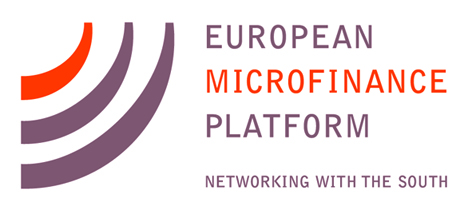(This  is the companion feature to an earlier piece on a European Microfinance Week conversation on serving refugees.)
is the companion feature to an earlier piece on a European Microfinance Week conversation on serving refugees.)
Swati Mehta Dhawan of Germany’s Catholic University of Eichstätt-Ingolstadt argued for building up legal frameworks to allow forcibly displaced persons (FDPs) to escape “infinite limbo” by accessing documentation for identification purposes, working legally and integrating with host populations. She offered the example of a person displaced to Kenya, who has been there for 15 years without being allowed to work. Hans-Martin Zademach, also of Catholic University, noted many are “stuck in survival mode,” more in need of a reliable income source than methods for managing money.
However, Ms Dhawan explained that FDPs’ needs for financial services often increase as years go by. A common trajectory is to: (1) require only basic financial services for one to two years as the person depends primarily on humanitarian aid; (2) be able to benefit from small loans and payment services as she begins to generate income during years three through five; (3) want savings and larger loans thereafter as she may be starting a business or otherwise attaining greater financial stability.
Ms Dhawan’s data are from Jordan, where FDPs are allowed to financial services but do so only minimally due to low income levels. This contrasts with Kenya, where FDPs are only allowed to use certain elements of the mobile money service M-Pesa within the confines of the refugee camp. Due to this restriction, outside the camp, people often use other people’s accounts to meet their needs.
Felix Okech, of the UN’s World Food Programme, described his work in Kenya, where he said the know-your-customer requirements are too strict to allow FDPs to use many financial services – mobile or in-person. For example, UN-provided identity cards are not accepted under government rules, due to concerns about terrorism funding. While the government has allowed aid vouchers to be disbursed via M-Pesa, other services remain closed to FDPs. The Central Bank of Kenya has signaled it would approve opening more M-Pesa services to FDPs, but this has been blocked by the country’s Financial Reporting Centre, whose mission is to prevent financial crimes.
Despite this, a very small number of FDPs are being allowed to receive food assistance via bank accounts as a pilot program of the World Food Programme and the US-based nonprofit International Rescue Committee. There are also a few refugees who have managed to become registered as retailers, which gives them more access to financial services. Mr Okech describes this as having a positive ripple effect through the FDP community. He added, “In terms of credits, refugees are very creative – creating their own credit groups and accessing hawala,” a form of long-distance value transfer that is based in Islamic tradition. Meanwhile, some retailers in Kenya have been willing to lend to FDPs, who use the credit to manage the difficulties of being provided only about 60 percent of the food they need.
Erica Van Eeghen of the Dutch public-private partnership FMO described her firm’s Nasira fund, which offers partial guarantees to banks that lend to FDPs and other target populations. For most FDPs, FMO has found, “credit alone does not serve the group well because they are too vulnerable.” Hence Nasira focuses on refugees living outside of camps, who are more integrated with host communities and often operate small businesses. For Syrian FDPs living in Jordan, on-boarding remains challenging due to regulatory hurdles.
When attempting to include FDPs in financial services, Dr Zademach argued it is better to adjust the services to the needs of refugees rather than pushing refugees to use mainstream services. Some FDPs are doing this without external assistance, for example by using “WhatsApp to organize themselves” into savings groups. The moderator of the session, Daphne Jayasinghe of the International Rescue Committee, stated that despite a myriad of challenges, “What really came across is the creativity of refugees themselves in creating economic opportunity.”
This feature is part of a sponsored series on European Microfinance Week 2020, which took place online from November 18 through November 20. The event is held annually by e-MFP. MicroCapital has been engaged to promote and report on the conference each year since 2012.
Sources and Additional Resources
“COVID-19 and Refugees’ Economic Opportunities, Financial Services and Digital Inclusion”
https://eu.rescue.org/report/covid-19-and-refugees-economic-opportunities-financial-services-and-digital-inclusion
German Federal Ministry for Economic Cooperation and Development (BMZ) newsletter on the financial lives of refugees and migrants in Jordan, Kenya, Uganda, Mexico, and Ethiopia
https://find.substack.com/about
MicroCapital on Nasira guarantee to lenders to refugees in South Africa
https://www.microcapital.org/microcapital-brief-nasira-guaranteeing-35m-in-digital-lending-by-sasfin-to-smes-owned-by-migrants-women-youth-in-south-africa-from-emergency-covid-19-facility-funded-by-eu-fmo/
European Microfinance Platform (e-MFP) information on European Microfinance Week 2020
http://www.e-mfp.eu/european-microfinance-week-2020
MicroCapital coverage of European Microfinance Week, including the European Microfinance Award
https://www.microcapital.org/category/european-microfinance-week/
Similar Posts:
- SPECIAL REPORT: Financial Inclusion of Forcibly Displaced Persons (FDPs), Host Communities Results in Competitive PAR Ratios #EMW2023
- SPECIAL REPORT: Leveraging Financial Inclusion to Get Food Security Back on the Increase #EMW2023
- SPECIAL REPORT: Yikri of Burkina Faso Wins $110k European Microfinance Award for Progress Toward Food Security #EMW2023
- SPECIAL REPORT: European Microfinance Week 2023 Is Almost Here! A Tour of the Upcoming Conference’s Sessions and Streams
- MICROFINANCE EVENT: European Microfinance Week; November 15-17, 2023; Luxembourg
